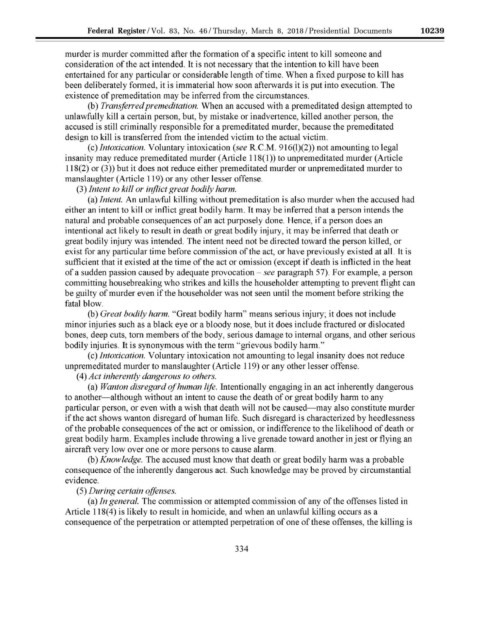Page 536 - Trump Executive Orders 2017-2021
P. 536
Federal Register / Vol. 83, No. 46 / Thursday, March 8, 2018 / Presidential Documents 10239
murder is murder committed after the formation of a specific intent to kill someone and
consideration of the act intended. It is not necessary that the intention to kill have been
entertained for any particular or considerable length of time. When a fixed purpose to kill has
been deliberately formed, it is immaterial how soon afterwards it is put into execution. The
existence of premeditation may be inferred from the circumstances.
(b) Transferred premeditation. When an accused with a premeditated design attempted to
unlawfully kill a certain person, but, by mistake or inadvertence, killed another person, the
accused is still criminally responsible for a premeditated murder, because the premeditated
design to kill is transferred from the intended victim to the actual victim.
(c)Intoxication. Voluntary intoxication (see R.C.M. 916(1)(2)) not amounting to legal
insanity may reduce premeditated murder (Article 118(1)) to unpremeditated murder (Article
118(2) or (3)) but it does not reduce either premeditated murder or unpremeditated murder to
manslaughter (Article 119) or any other lesser offense.
(3) Intent to kill or ir?fl.ict great bodi~v harm.
(a) Intent. An unlawful killing without premeditation is also murder when the accused had
either an intent to kill or inflict great bodily ham1. It may be inferred that a person intends the
natural and probable consequences of an act purposely done. Hence, if a person does an
intentional act likely to result in death or great bodily injury, it may be inferred that death or
great bodily injury was intended. The intent need not be directed toward the person killed, or
exist for any particular time before commission of the act, or have previously existed at all. It is
sufficient that it existed at the time of the act or omission (except if death is inflicted in the heat
of a sudden passion caused by adequate provocation- see paragraph 57). For example, a person
committing housebreaking who strikes and kills the householder attempting to prevent f1ight can
be guilty of murder even if the householder was not seen until the moment before striking the
fatal blow.
(b) Great bodily harm. "Great bodily harm" means serious injury; it does not include
minor injuries such as a black eye or a bloody nose, but it does include fractured or dislocated
bones, deep cuts, tom members of the body, serious damage to internal organs, and other serious
bodily injuries. It is synonymous with the term "grievous bodily harm."
(c) intoxication. Voluntary intoxication not amounting to legal insanity does not reduce
unpremeditated murder to manslaughter (Article 119) or any other lesser offense.
( 4) Act inherently dangerous to others.
(a) Wanton disregard ofhuman life. Intentionally engaging in an act inherently dangerous
to another-although without an intent to cause the death of or great bodily hann to any
particular person, or even with a wish that death will not be caused-may also constitute murder
if the act shows wanton disregard of human life. Such disregard is characterized by heedlessness
of the probable consequences of the act or omission, or indifference to the likelihood of death or
great bodily harm. Examples include throwing a live grenade toward another in jest or flying an
aircraft very low over one or more persons to cause alarm.
(b) Know ledge. The accused must know that death or great bodily harm was a probable
consequence of the inherently dangerous act. Such knowledge may be proved by circumstantial
evidence.
( 5) During certain offenses.
(a) In general. The commission or attempted commission of any of the offenses listed in
Article 118( 4) is likely to result in homicide, and when an unlawful killing occurs as a
sradovich on DSK3GMQ082PROD with PRES DOCS VerDate Sep<11>2014 18:39 Mar 07, 2018 Jkt 244001 PO 00000 Frm 00353 Fmt 4705 Sfmt 4790 E:\FR\FM\08MRE0.SGM 08MRE0 ER08MR18.355</GPH>
consequence of the perpetration or attempted perpetration of one of these offenses, the killing is
334

